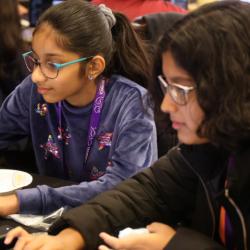Partnerships Empower Quantum Leaps
By launching two new centers devoted to specific aspects of quantum science, the University of Maryland is building on the model partnership that makes its Joint Quantum Institute (JQI) a leader in quantum physics research.
Founded in 2006, JQI is a research partnership between UMD and the National Institute of Standards and Technology, with the support and participation of the Laboratory for Physical Sciences. The institute is home to 34 fellows—senior researchers who are on JQI’s permanent staff—and over 100 students, postdoctoral researchers and visiting scientists. JQI scientists study the physical properties of the microscopic world. The institute’s strength is in quantum information, broadly defined to cover communication networks, sensors, computers, quantum simulators of complex materials, and dozens of other topics in basic and applied science. JQI is co-directed by UMD Physics Professor Steve Rolston and NIST Fellow Charles Clark.
One of JQI’s founding members is College Park Professor of Physics William Phillips, who shared the 1997 Nobel Prize in physics for using laser light to cool and trap atoms. “Our work sometimes has to do with practical things,” says Phillips, who is also a NIST Fellow. “It always has to do with really fundamental quantum mechanical problems and with understanding more clearly the way the world works.”
From the bench to the factory floor
UMD’s longstanding research partner, Lockheed Martin, signed an agreement with the university in March establishing the Quantum Engineering Center. The center’s mission is to develop a working quantum computer under the leadership of Bice Zorn Professor of Physics Christopher Monroe.
Monroe has been working on the design for a quantum computer since 1994. His newest experiment uses a manufactured 50-electrode silicon chip, replacing the hand-built chips used in earlier versions and making the innovation robust and reproducible. Monroe hopes Lockheed Martin’s engineers will push the production process along.
“Lockheed’s engineers can take our hand-crafted process and turn it into an assembly line, and that’s what we need,” Monroe says. “Our goal is to build a device where you don’t have to know its inner workings. You just use it. That requires serious engineering. I think a 10-year time frame is reasonable to develop such a device.”
Preparing for a quantum future
Completing the circle of quantum science expertise, the university’s new Joint Center for Quantum Information and Computer Science (QuICS) will tackle questions about the uses for such a computer and its impact on science and society.
The center, which resides in the University of Maryland Institute for Advanced Computer Studies, was officially launched in October with a $2 million, two-year federal grant. A partnership between UMD and NIST, with the support and participation of the Research Directorate of the National Security Agency/Central Security Service, QuICS is co-directed by JQI Fellow and NIST Physicist Jacob Taylor and Computer Science Associate Professor Andrew Childs.
The researchers will think through the possibilities and limitations of a computer that does not yet exist. The futuristic nature of their work poses certain dilemmas. For example, “If you want to understand the performance of a classical algorithm, you can just run the algorithm and see how it works,” says Childs. “Understanding quantum algorithms is harder because we can’t yet run them.”
QuICS researchers want to better understand the kinds of tasks quantum technologies can handle better than conventional ones and what a quantum computer can teach us about the quantum nature of our world. “Exploring that boundary between the two realms is our main focus,” says Taylor.
Writer: Heather Dewar
See also:







